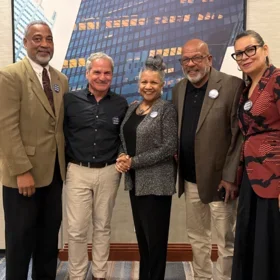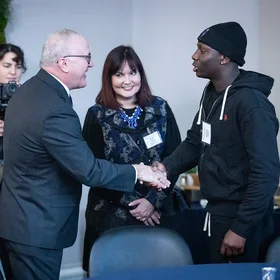A conversation with Columbia Community Scholar John Reddick, an architect and Harlem historian, makes New York come alive. Even better, his expertise — in Harlem and its history, the pulsing artistic beat that created modern music as we know it — shows the art and energy that have shaped Columbia’s neighborhood, the city, and the world for the last century.
On November 4, Reddick will give a lecture, “Ragtime to Jazz Time: Harlem’s Black and Jewish Music 1890 - 1930,” highlighting the research that he’s done as a Community Scholar, using the era’s sheet music to illustrate the cultural links between Harlem’s turn-of-the-century African American composers (James Reese Europe, H.T. Burleigh) and Jewish composers (George Gershwin, Richard Rodgers), and the back-and-forth influence they had on jazz and popular music.
Reddick, a resident of Harlem since 1980 and “semi-retired” now at 65, has architectural experience extending to work on Harlem’s public art projects, including the Frederick Douglass Circle and the Ralph Ellison memorial. To him, being a Community Scholar is “a conduit to a lot of other things.” When he joined the Community Scholars program, he took classes in history and jazz for a year and conducted two years of research in Columbia’s libraries. And he recognizes the benefits of the Columbia name in even small ways. For example, his Columbia email address ensures his messages get a faster response rate when they land in a recipient’s crowded inbox.
In his scholarly work, he’s been able to draw together the “cross-pollination” of Harlem. “We set the beat, they set the lyrics,” he says, referring to the African American and Jewish influence in the American songbook. “It’s a story agreed-upon, and who better to write that than outside players.” He found connection after connection on how African-American and Jewish musicians expressed their outsider feelings in society through their art. In one example, a character from Show Boat is a mixed-race woman “passing” for white; the story, authored by Jewish writer Edna Ferber, expresses a universal “outsiderness.” Reddick says, “the more you write character as an outsider, the more people relate and pick up on it.”
The name James Reese Europe comes up frequently in conversation with Reddick. A major Harlem bandleader in the 1910s, Europe played the music for dances like the bunny hop and the foxtrot, and led the regiment band from Harlem in World War I. Nicknamed “the Harlem Hellfighters,” this regiment, on their return to New York, were feted in a parade that went up Fifth Avenue and ended in Harlem, marking the birth of the Harlem Renaissance, some say.
As with many New York City neighborhoods, even locals dispute boundaries. Reddick sees Harlem stretch up from 96th Street to the George Washington Bridge, citing the Harlem Heights of Revolutionary War maps, “from river to river — and I still see it that way; I refuse to look at the real estate maps.” Yet the stories he tells transcend these boundaries, expanding them to redefine Harlem as the “premiere African American community throughout the world.”
Read the Columbia News article on Reddick and watch his lecture online in six parts:
- Program Introductions
- Rosamond Johnson – Under the Bamboo Tree
- Harlem’s Early Development & Entertainment
- Antonín Dvořák & Black Composers
- Harlem's Theaters
- Lafayette Theater – Black Performance
The Columbia Community Scholars Program, administered by the Office of Government and Community Affairs and the School of Professional Studies, enables independent scholars to pursue their lifelong learning aspirations, whether it be completing an independent project or attaining skills in a particular area. The program helps to foster and deepen ties between the University and the many independent members of the cultural and intellectual community surrounding it.


